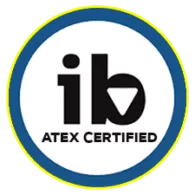ATEX CERTIFIED PRODUCTS FOR EX ZONES
Solutions Against Sparks and Fire During Floods in Ex Zones: Mining, Gas, and Oil Industry

Understanding the Risks of floods in EX zones
In Ex zones, the presence of flammable gases, liquids, and dust creates an environment where even a small spark can lead to a major fire or explosion. Floods exacerbate these risks by introducing water into areas where it can cause electrical short circuits, equipment malfunctions, and chemical reactions. Key risk factors include:
Electrical Hazards: Water can cause short circuits in electrical systems, leading to sparks.
Chemical Reactions: Floodwater can mix with chemicals, creating flammable or explosive compounds.
Mechanical Failures: Flooding can damage equipment, leading to malfunctions that generate sparks.
Preventive Measures
To mitigate the risks of sparks and fires during floods, industries must adopt a multi-faceted approach that includes both preventive and reactive measures.
Robust Electrical Systems: Ensuring that electrical systems are waterproof and equipped with automatic shut-off mechanisms can prevent short circuits. Regular maintenance and inspections are essential to identify and rectify potential vulnerabilities.
Chemical Safety: Proper storage and handling of chemicals can prevent dangerous reactions. Using flood-resistant containers and ensuring that chemicals are stored above potential flood levels can minimize risks.
Equipment Maintenance: Regular maintenance of machinery and equipment can prevent malfunctions. Installing spark arrestors and using non-sparking tools in Ex zones can further reduce the risk of ignition.
Advanced Technologies and ATEX certified products
Implementing advanced technologies can significantly enhance safety in Ex zones during floods.
Fire Detection and Suppression Systems: Installing state-of-the-art fire detection systems, such as smoke detectors, heat sensors, and flame detectors, can provide early warnings of fire incidents. Automatic fire suppression systems, including water sprinklers, foam systems, and gas suppression systems, can quickly contain and extinguish fires.
Flood Monitoring Systems: Advanced flood monitoring systems can provide real-time data on water levels and potential flood risks. Integrating these systems with emergency response protocols can ensure timely actions to prevent fires.
Remote Monitoring and Control: Utilizing remote monitoring and control systems allows for the management of equipment and safety systems from a safe location. This can be particularly useful during floods when access to certain areas may be restricted.
Emergency Response Planning
Having a comprehensive emergency response plan is crucial for minimizing the impact of floods and preventing fires in Ex zones.
Training and Drills: Regular training and emergency drills for employees can ensure that everyone knows how to respond in case of a flood or fire. This includes evacuation procedures, use of fire extinguishers, and first aid.
Emergency Equipment: Ensuring that emergency equipment, such as fire extinguishers, first aid kits, and personal protective equipment (PPE), is readily available and in good condition can save lives and prevent injuries.
Communication Systems: Reliable communication systems are essential for coordinating emergency responses. This includes both internal communication within the facility and external communication with emergency services.
Best Practices
Learning from past incidents and adopting best practices from other industries can provide valuable insights into effective flood and fire prevention strategies.
Oil Refinery Flood Response: An oil refinery implemented a comprehensive flood response plan that included elevated storage tanks, waterproof electrical systems installed in special, explosion-proof ATEX certified protection boxes, advanced fire suppression systems and oil in water detection systems like Inov8 probe. During a major flood, these measures can successfully prevent any fires or explosions.
Best Practice: Mining Industry: The mining industry has adopted various best practices, such as using non-sparking tools, regular equipment maintenance, and robust emergency response plans. These practices have significantly reduced the risk of fires during floods.
Preventing sparks and fires during floods in Ex zones requires a combination of preventive measures, advanced technologies like ATEX certified products, and comprehensive emergency response planning. By adopting these strategies, industries can enhance safety, protect their assets, and ensure the well-being of their employees. Continuous improvement and learning from past incidents are key to staying ahead of potential risks and maintaining a safe working environment.

